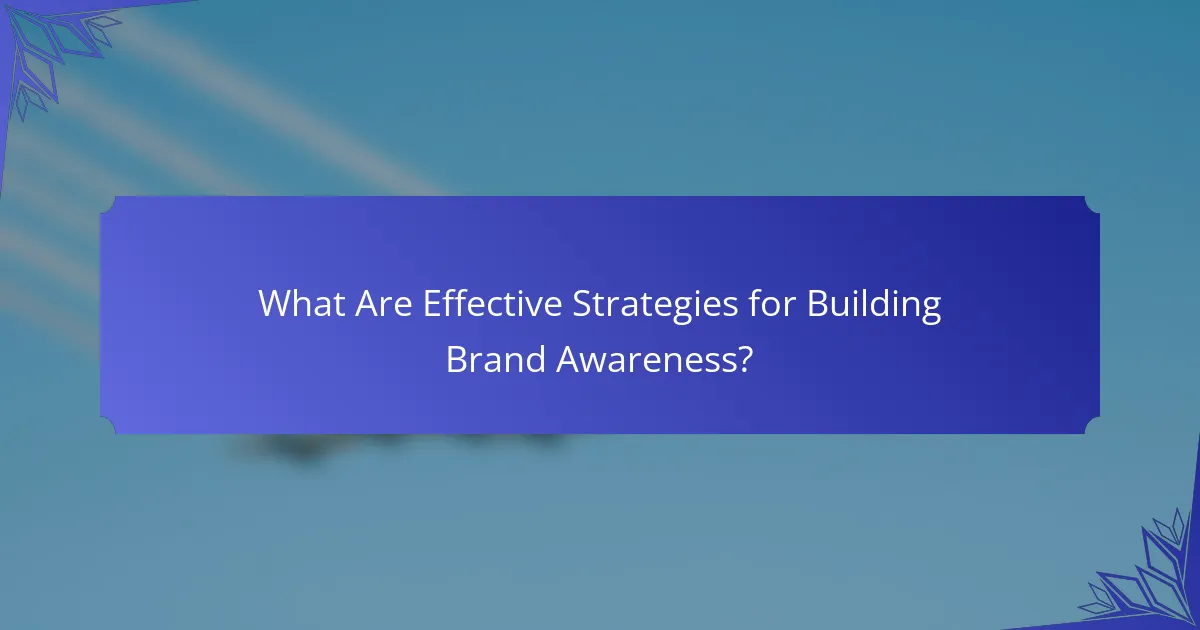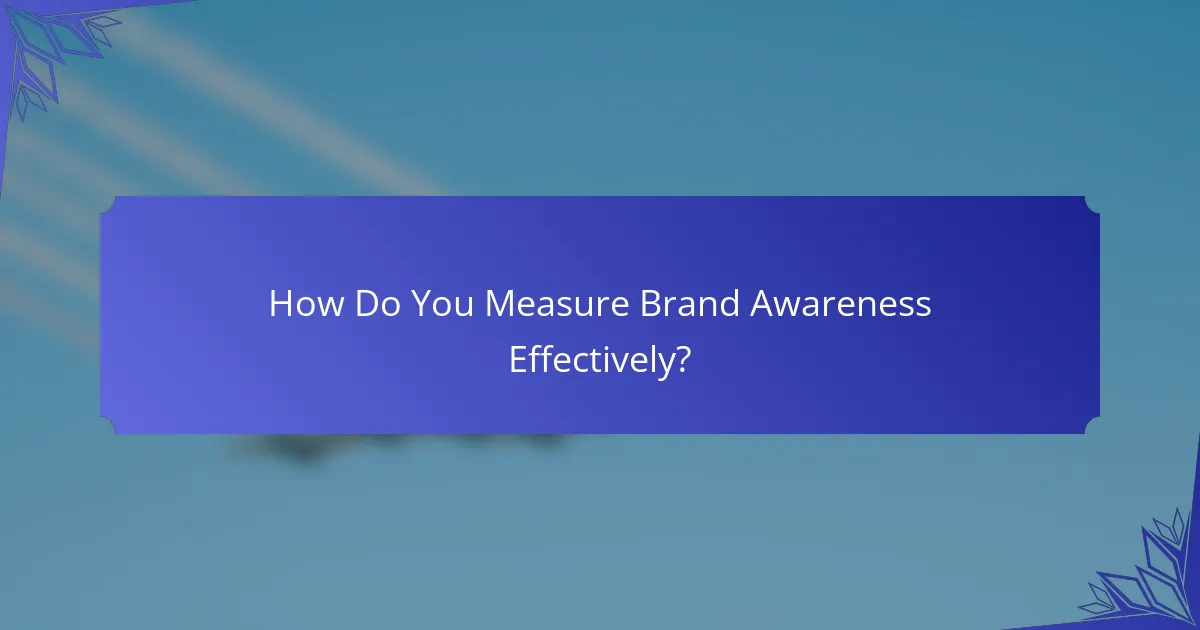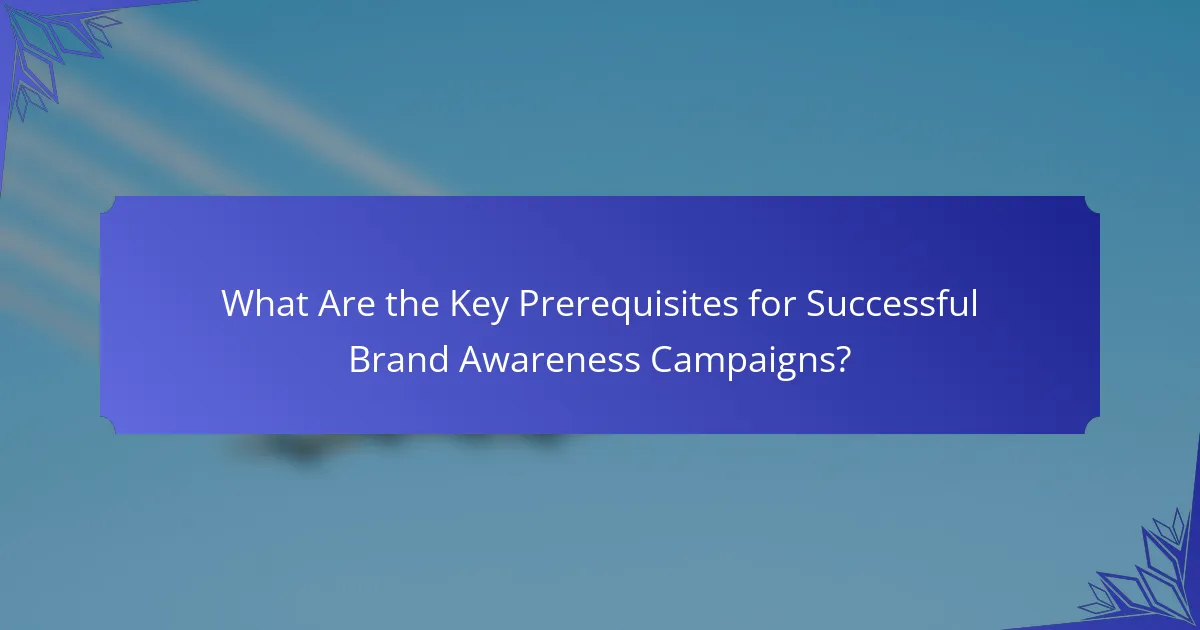Building brand awareness is essential for any business looking to establish a strong presence in the market. By employing a combination of digital marketing techniques and engaging with local communities, brands can enhance their visibility and foster meaningful connections with potential customers. Additionally, a strategic approach to market entry, including thorough research and audience targeting, is crucial for successfully positioning a brand in new markets.

What Are Effective Strategies for Building Brand Awareness?
Effective strategies for building brand awareness include a mix of digital marketing techniques that enhance visibility and recognition. These strategies leverage various platforms and methods to engage potential customers and create lasting impressions.
Content Marketing
Content marketing involves creating valuable, relevant content to attract and engage a target audience. This can include blogs, videos, infographics, and podcasts that resonate with your brand’s message. Consistent, high-quality content helps establish authority and fosters trust among potential customers.
To maximize impact, consider using a content calendar to plan and schedule posts. Aim for a mix of educational and entertaining content that aligns with your audience’s interests. Regularly updating your content can keep your brand top-of-mind.
Social Media Engagement
Social media engagement is crucial for building brand awareness as it allows direct interaction with your audience. Platforms like Facebook, Instagram, and Twitter enable brands to share updates, respond to inquiries, and participate in conversations. Engaging posts can increase visibility and encourage sharing among users.
Focus on creating shareable content, such as polls, contests, or behind-the-scenes glimpses of your brand. Regularly monitor engagement metrics to understand what resonates with your audience and adjust your strategy accordingly.
Influencer Partnerships
Influencer partnerships involve collaborating with individuals who have a significant following in your target market. These influencers can promote your brand through authentic endorsements, which can lead to increased visibility and credibility. Choose influencers whose values align with your brand for a more genuine connection.
When selecting influencers, consider their engagement rates and audience demographics. A smaller influencer with a highly engaged audience can sometimes be more effective than a larger one with less interaction. Establish clear expectations and goals for the partnership to ensure mutual benefit.
Search Engine Optimization
Search engine optimization (SEO) is the practice of enhancing your website to rank higher in search engine results. This involves optimizing content with relevant keywords, improving site speed, and ensuring mobile-friendliness. Effective SEO increases organic traffic and enhances brand visibility.
Start by conducting keyword research to identify terms your target audience is searching for. Regularly update your website with fresh content and optimize existing pages to improve rankings. Monitor your SEO performance using tools like Google Analytics to track progress.
Email Marketing Campaigns
Email marketing campaigns are a direct way to communicate with your audience and build brand awareness. By sending targeted emails, you can share news, promotions, and valuable content that keeps your brand in front of potential customers. Personalization can significantly enhance engagement rates.
Segment your email list based on customer behavior and preferences to tailor your messages. Aim for a consistent schedule, but avoid overwhelming your audience with too many emails. Track open rates and click-through rates to refine your approach and improve future campaigns.

How Can Local Markets Enhance Brand Awareness?
Local markets can significantly boost brand awareness by fostering community connections and enhancing visibility. Engaging with local consumers through tailored strategies helps brands resonate more deeply and build trust.
Community Involvement
Being active in the community is a powerful way to enhance brand awareness. Brands can participate in local events, sponsor community activities, or support local charities, which demonstrates commitment and builds goodwill.
For example, a coffee shop might host open mic nights or art shows featuring local artists. This not only draws in customers but also strengthens the brand’s identity as a community hub.
Local SEO Tactics
Implementing local SEO strategies is essential for improving online visibility in specific markets. This includes optimizing Google My Business profiles, using local keywords, and gathering customer reviews to rank higher in local search results.
Brands should ensure their name, address, and phone number (NAP) are consistent across all platforms. This consistency helps search engines verify the business’s legitimacy and improves local search rankings.
Partnerships with Local Businesses
Forming partnerships with local businesses can amplify brand awareness through cross-promotion. Collaborating with complementary businesses allows brands to tap into each other’s customer bases, creating mutual benefits.
For instance, a gym could partner with a local health food store to offer discounts to each other’s customers. This strategy not only increases visibility but also enhances the perceived value of both brands within the community.

What Are the Best Tactics for Market Entry?
The best tactics for market entry involve a strategic approach that combines thorough research, targeted audience identification, and competitive analysis. These elements help businesses effectively position themselves in a new market and maximize their chances of success.
Market Research and Analysis
Market research and analysis are crucial for understanding the dynamics of a new market. This involves gathering data on market size, growth potential, and consumer behavior. Utilize surveys, focus groups, and industry reports to gain insights into local preferences and trends.
Consider employing both qualitative and quantitative methods to obtain a comprehensive view. For example, qualitative interviews can reveal deeper motivations behind consumer choices, while quantitative data can provide statistical backing for market size estimates.
Target Audience Identification
Identifying the target audience is essential for tailoring marketing strategies effectively. Start by segmenting the market based on demographics, psychographics, and buying behaviors. This will help pinpoint the most promising customer groups.
Utilize tools like customer personas to visualize your ideal customers. For instance, if entering a European market, consider factors such as age, income, and lifestyle preferences that vary significantly across countries. This ensures your messaging resonates with the right audience.
Competitive Analysis
Conducting a competitive analysis allows you to understand the strengths and weaknesses of existing players in the market. Identify key competitors and analyze their product offerings, pricing strategies, and marketing tactics. This information can inform your own approach and highlight gaps in the market.
Use a SWOT analysis (Strengths, Weaknesses, Opportunities, Threats) to evaluate your position relative to competitors. This method can help you determine where to focus your efforts, whether it’s on pricing, unique features, or customer service enhancements.

How Do You Measure Brand Awareness Effectively?
Measuring brand awareness effectively involves using a combination of qualitative and quantitative methods to gauge how well consumers recognize and recall your brand. This can include direct feedback, social media engagement, and website traffic metrics.
Surveys and Feedback
Surveys are a direct way to assess brand awareness by asking consumers about their familiarity with your brand. Consider using a mix of multiple-choice and open-ended questions to gather both quantitative data and qualitative insights. Aim for a sample size that reflects your target market, typically in the hundreds for meaningful results.
Feedback can also be collected through focus groups or interviews, allowing for deeper exploration of consumer perceptions. Ensure questions are clear and unbiased to get honest responses.
Social Media Metrics
Social media platforms provide valuable metrics for measuring brand awareness, including reach, impressions, and engagement rates. Track how many people see your posts and how they interact with them to understand your brand’s visibility. A good benchmark is to aim for an engagement rate of around 1-3% for most industries.
Utilize tools like Google Analytics or native platform insights to analyze trends over time. Look for spikes in engagement following campaigns or promotions, as these can indicate increased brand awareness.
Website Traffic Analysis
Website traffic analysis helps measure brand awareness through metrics such as unique visitors, page views, and time spent on site. An increase in traffic can suggest that more people are searching for your brand or engaging with your content. Tools like Google Analytics can provide detailed insights into user behavior.
Monitor referral sources to see where your traffic is coming from. High referral traffic from social media or other websites can indicate successful brand recognition. Aim for a steady increase in organic traffic, which reflects growing brand awareness in your target audience.

What Are the Key Prerequisites for Successful Brand Awareness Campaigns?
Successful brand awareness campaigns require a clear understanding of your target audience and a well-defined brand identity. These elements ensure that your messaging resonates and stands out in a crowded market.
Clear Brand Messaging
Clear brand messaging is essential for effective brand awareness. It involves articulating your brand’s values, mission, and unique selling propositions in a way that is easily understood by your audience. This clarity helps consumers quickly grasp what your brand stands for and why it matters to them.
To create clear messaging, consider using simple language and avoiding jargon. Focus on the benefits your product or service provides, and ensure that your core message is consistent across all platforms, whether it’s social media, your website, or advertising materials. For example, a brand selling eco-friendly products might emphasize sustainability and health benefits in its messaging.
Regularly test your messaging with your audience to gauge understanding and resonance. Gather feedback through surveys or focus groups to refine your approach. Avoid common pitfalls such as overcomplicating your message or failing to align it with your brand’s identity, as these can confuse potential customers and dilute brand recognition.


